|
Four members of BIMS visited the Manchester Museum on Thursday 18th February 2010. The visit had been arranged many months before by BIMS member David Entwistle, who had contacted the museum's Mineralogy Curator Dr David Green. The Manchester Museum is owned by Manchester University and opened to the public at it's current location, on Oxford Road at the heart of the campus, during 1888. It houses significant collections in many disciplines (including the fourth largest collection of molluscs in Britain!), although our visit was only concerned with their meteorites. The museum has had extensive redevelopments which opened in 2003.
After meeting, Dr Green took us over to the permanent public meteorite display. This is a sizable single cabinet, with descriptions and examples of the main meteorite classifications. These specimens included the main mass (~1.2kg) of Sinai, an L6 which was seen to fall in Egypt in 1916. The Catalogue of Meteorite lists just 239.5g divided between three other institutions including the Natural History Museum, London.
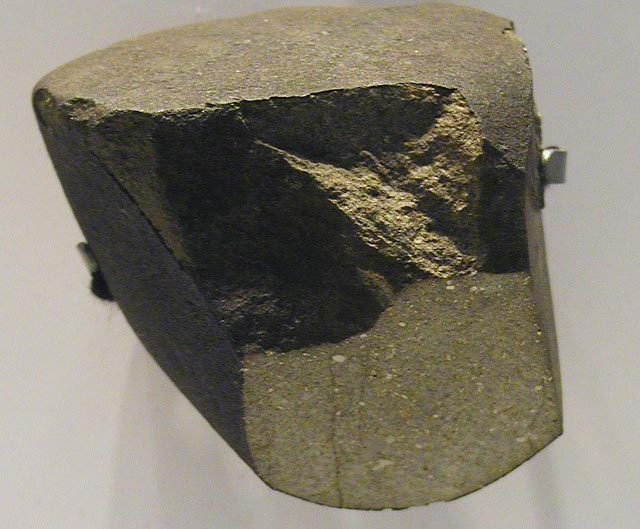 Sinai (L6) Main-Mass (Image courtesy of David Entwistle)
Other specimens in the public display included Millbillillie (Eucrite), Bjurbole (L/LL4), Monze (L6), Canyon Diablo (IAB-MG), Turtle River (IIIAB), Odessa (IAB-MG), Toluca (IAB-sLL), Brenham (Pallasite), Bondoc (Mesosiderite), Allende (CV3), Wells (LL3.3), Hedjaz (L3.7-6), Plainview (H5) and Appley Bridge (LL6). Appley Bridge is the most local fall to the museum, occurring just 21 miles away near Wigan. To our amusement Dr Green described the specimen on display as "small". I would estimate the mass to be in the 100-200g range, suggesting that there are only 4 museums world-wide with larger samples. We were then taken to see the meteorites which are not on public display. Dr Green brought the Appley Bridge with us so that we could take photographs in a better lit location, the Museum also has a cast of the complete stone:
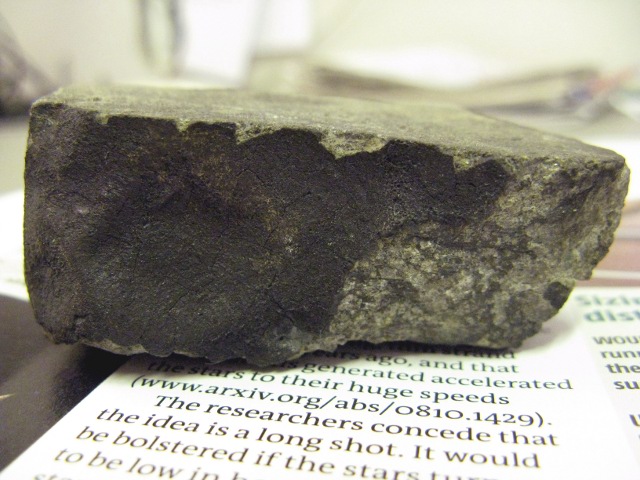 Side view of the Appley Bridge specimen, showing fresh looking crust.
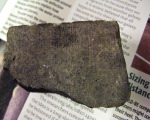 |
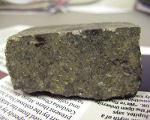 |
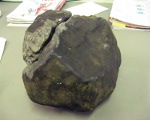 |
| Appley Bridge - Cut face |
Appley Bridge - Side face |
Appley Bridge - Cast of complete 15kg stone |
For the next couple of hours we pored over the other two hundred or so specimens in the Museum's collection. The majority of these were contained in a number of large drawers, as pictured below. Every specimen is stored with the specimen cards and labels it has acquired whilst at the Museum and previously.
A large portion of the collection was given to the Museum at the bequest of Howard J. Axon upon his death in 1992. H.J. Axon studied metallurgy, before taking up a post at Manchester University in 1949. After researching non-ferrous alloys for around a decade his interest began to move towards the metal content of meteorites, a subject on which he published a number of papers. The mineral "Haxonite" was named after him in 1971 and he retired from the University in 1982.
In 1963 Howard J. Axon published a paper in Nature titled "Destruction of the Widmanstatten Structure in Iron Meteorites by Laboratory Heat Treatment". In this he aims to establish the conditions which would result in the natural (cosmic) partial destruction of the Widmanstatten structures in some meteorites (he cites Kamkas as an example, better known now as Gibeon). The study consisted of sealing small Canyon Diablo specimens in silica capsules and heating them to different temperatures before observing the effects. If you look on the left hand side of the drawer photograph above you can see four of these silica capsules (round, green, glassy objects), each has been cut open to reveal the meteorite fragment contained within. There were many other specimens which had formed part of his research, including a large number of Canyon Diablo and Toluca partslices in small packets, each labeled with the temperatures and pressures they had been exposed to.
A number of historical specimens came from the collection of David Forbes (1828-1876) a British mineralogist, metallurgist and chemist. After his death, his extensive collection of books and minerals were purchased by Manchester University. The minerals (including meteorites) then became part of the Manchester Museum collection. Below you can see an image of one of David Forbes' original collection labels, this accompanied three small Pultusk (H5) individuals that were incredibly fresh. The label shows that they entered the Forbes collection in 1870, just two years after the fall, they have clearly been well curated since this time as shown in the additional images below. Also note that the label gives the date of the fall as 30th January 1869, although the actual year of the fall was 1868.
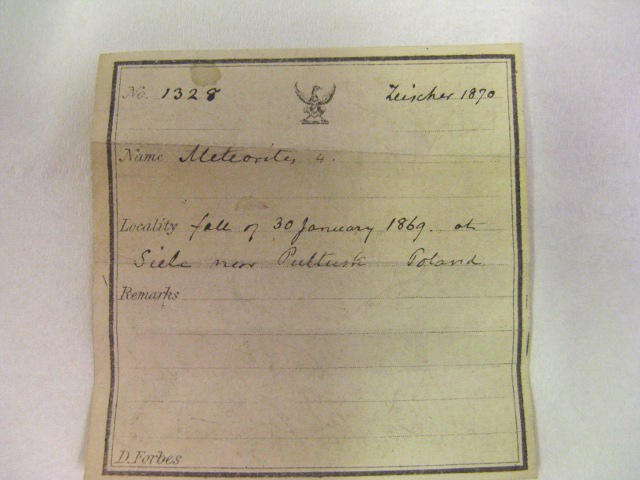 David Forbes' original Pultusk meteorite label from 1870.
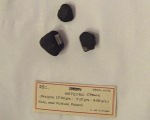 |
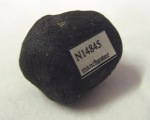 |
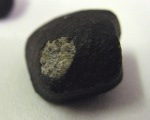 |
| All three Pultusk specimens with their later Manchester Museum label |
Close-up of 17.03g Pultusk specimen |
Close-up of 7.24g Pultusk specimen |
Among the other interesting specimens was a 51g partslice of La Grange (IVA) an 1860 find from Kentucky, USA. The Widmanstatten pattern was just visible on the specimen, depending on how light hit the surface. Buchwald mentions that "Etched sections display a rather dull, indistinct Widmanstatten structure, that in places is quite distorted". In 1861 it was described in the American Journal of Science and Arts (Volume 31) by J. Lawrence Smith. He wrote "It was discovered in the month of October 1860, by Mr Wm. Daring near Lagrange, in Oldham County, KY. There is nothing known with reference to the time of its fall. It came into my possession shortly after its discovery. It was entire and weighed one hundred and twelve pounds. Its extreme dimensions were, length twenty, breadth ten and three-fourths and thickness six and a half inches; its shape was elongated and flattened". This is equivalent to a mass of 50.8kg and size 50.8 x 26.0 x 16.5 cm. J.L. Smith cut and distributed pieces from each end of the mass, this piece found it's way into the Forbes collection before arriving at the Manchester Museum. The main mass of 36.3kg (from the Catalogue of Meteorites, Buchwald lists it as 35.5kg) resides at ASU and is 27 x 25 x 15 cm in size.
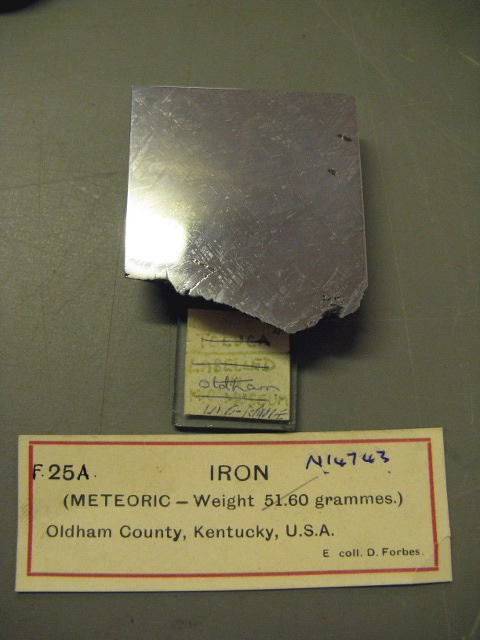 La Grange (IVA) 51.60g with a faintly visible Widmanstatten pattern
We were also slightly surprised to find a significant number of specimens with American Meteorite Laboratory labels, these had been in the collection left to the Museum by Howard J. Axon. The specimens included Densmore (1879) (L6), Grassland (L4), Brownfield (1937) (H3.7), Loop (L6), Armel (L5), Dresden (Kansas) (H5), Plains (H5), Roy (1933) (L5), Tell (H6), Calliham (L6) and others.
 |
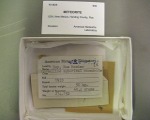 |
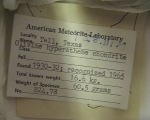 |
| Calliham (L6) AML Label |
Old and New Roy (L5) Labels |
Tell (H6) AML Label |
Prior to Dr Green joining the Museum, a number of the meteorite specimens had become separated from their labels as I'm sure happens from time to time in collections of this age. Dr Green has clearly spent a great deal of time cataloging the collection and has used archived records to match these specimens to their associated documentation. In one drawer we did find this beautiful crusted individual stone, which still awaits identification. Dr Green is confident sufficient archived records exist that it will eventually be re-identified. Given the nature of the Museum's collection, it is very likely this came from a historical fall.
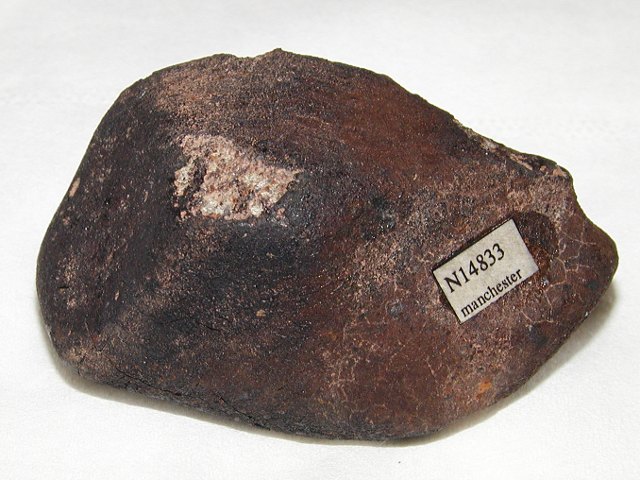 N14833 Mystery Meteorite (Image courtesy of David Entwistle)
I would like to thank the following people: Dr David Green for his hospitality and making us feel so welcome at the Museum. David Entwistle for arranging the visit and providing some of the background information on Howard J. Axon. David Entwistle, Martin Goff and Graham Ensor for helping to making the visit so memorable. Dave Myers, Phil Whitmer and Howard McLean who helped me out with information on La Grange.
Unless otherwise stated all text and images are (c)2010 M. Smith. Images were taken with permission from Manchester Museum.
References and Further Reading:
- Wikipedia - Manchester Museum
- Howard J. Axon Memorial (Meteoritics Vol 27, 1992) by Bevan, A., Ridley, N., & Sears, D. Local pdf here.
- Wikipedia - David Forbes
- Wikipedia - Haxonite
- Description of three new Meteorites (American Journal of Science and Arts (2nd series); Volume 31), J. Lawrence Smith. Includes La Grange as Oldham County. Local copy page 1 and 2.
- Space Visitors in Kentucky - Ehmann, W.D. & Anderson, W.H.. Local pdf here.
- Axon, H.J. - A Note on Widmanstatten Crystallography (Meteoritics Vol.21, No.2, 1986).
- Axon, H.J. - Destruction of the Widmanstatten Structure in Iron Meteorites by Laboratory Heat Treatment (Nature, 30th March 1963).
- Axon, H.J. - The Cracking History of Serrania De Varas: An Alternative View (Meteoritics Vol.17, No.2, 1982).
- Handbook of Iron Meteorites: Their History, Distribution, Composition, and Structure - Buchwald, V.F..
- The Catalogue of Meteorites (Fifth Edition) - Grady, M.M..
|

